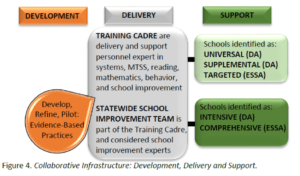This is the third post in our eight-part blog series on using research evidence under the Every Student Succeeds Act (ESSA). Check back every week for the latest installment. Also, be sure to sign up for our March 7 webinar, ESSA and Research Evidence: Opportunities and Challenges for States.
We’re at a unique inflection point for evidence-based practice in education with passage of the Every Student Succeeds Act (ESSA). In particular, the federal law offers states the opportunity to rethink their system of school improvement, with many of the NCLB-era restrictions dissolved. State education agencies (SEAs) have an opportunity to lean-in, building on previous lessons and experiences, and take bold action to improve their lowest-performing schools.
While states have a great deal of flexibility on school improvement in ESSA, the evidence-based practice requirement for school improvement funding and plans is a significant new component for state education agencies to incorporate into their systems in order to meet ESSA requirements. School improvement plans must be evidence-based and may use any level of evidence (strong, moderate, promising, or demonstrating a rationale), whereas funding from the 7% Title I set aside for school improvement must be used for interventions meeting only the top three tiers of evidence (strong, moderate, promising).
The main motivation for state chiefs around implementing the evidence-based practice provision in ESSA is that this can help the lowest performing schools improve more quickly and significantly than they could on their own. However, simply having schools pick from a list of evidence-based programs will not translate into better outcomes for kids. With that in mind, state education agencies are considering how they provide support, technical assistance, and incentives to schools and districts so evidence-based practices can be used more often, are tied to local needs and populations, and be sustained over time. Below are five key areas states are exploring.
1. Needs assessment
Schools are required to conduct a needs assessment if they’re identified under ESSA for comprehensive support and improvement or targeted support and improvement. In order to identify an appropriate evidence-based practice, first the school must identify the root causes of under-performance. Iowa, for example, in its draft ESSA plan, indicates the state intends to create online modules for conducting a district and/or school-level needs assessment for local leaders to use in the fall of the planning year.
2. Knowledge of evidence-based interventions
Often schools and districts don’t know where to start looking when identifying what works. Educators might receive calls and visits from vendors who claim their products are evidence-based, but how is a leader to know? There are more resources than ever for schools and districts to tap into, such as the What Works Clearinghouse, Results First Clearinghouse Database, Best Evidence Encyclopedia, the forthcoming Evidence for ESSA site, the LEA Guide to School Improvement Interventions from the Florida Center on Reading Research, and RAND’s report on school leadership interventions under ESSA.
To help school and district personnel navigate the universe of evidence-based practices for school improvement, some states – including Ohio, South Carolina, Vermont, and Washington, as indicated in their draft ESSA plans – are considering creating their own list of evidence-based strategies and programs. Washington intends to build on requirements in existing state law so that all schools identified for improvement will use its Menus of Best Practices for Mathematics, English Language Arts (ELA), and Behavior.
3. Professional development.
Many SEAs are planning to provide professional development and clear guidance and tools to schools and LEA staff, directly or through regional entities and/or coaches, on understanding of the full range of evidence-based options, matching root causes from the needs assessment to selected interventions, and how to develop strong implementation plans for selected evidence-based interventions.
One way states are providing professional development is through collaboration across offices and divisions within the SEA. States like Utah, Arkansas, Georgia, and Iowa are working across the school improvement and special education teams (among others) to streamline support to LEAs and schools. Combining expertise and resources across teams can bolster SEA capacity to support LEAs and schools. Below is a graphic from Iowa’s draft ESSA plan illustrating how evidence is part of the overall statewide system of support for students, educators and schools, which they call their ‘collaborative infrastructure’.
4. Use of Funds
Recipients of school improvement funds (7% Title I set-aside) are required to use evidence-based interventions. Some states are considering awarding school improvement funds with a requirement that the applicant draw on the full body of evidence rather than just one study (which is the minimum requirement in the law) and/or that there’s a strong link between how well the evidence-based practice matches the identified root cause(s). For example, Maryland’s draft ESSA plan indicates the state is considering awarding funds competitively, “based on the quality of the intervention plan’s alignment of evidence-based strategies to the prioritized needs.”
5. Supporting and Evaluating Implementation
An evidence-based practice is only as good as its implementation. States will be examining fidelity of implementation of evidence-based approaches and their evidence of impact, not just whether an evidence-based practice is part of the plan. In reflecting on local implementation, some states are also gathering and generating evidence about what practices are working in the state and for whom so that they’re expanding the universe of evidence-based practices available. For example, Massachusetts has developed an evidence-based framework for school improvement actions. The MA framework is based on research and evaluation reports conducted on practices used in its schools.
On the other side of the country, Montana has indicated in the state’s draft ESSA plan that the state will “use past and current work that shows strong or promising evidence for helping schools. The practices implemented under the Schools of Promise (SIG funded) initiative, such as wraparound services, student engagement, and school board coaching, have proved to be highly effective and endorsed by stakeholders.”
Advancing use of evidence in school improvement efforts is one piece of helping kids in the lowest performing schools have better educational outcomes. To help states in these efforts, the Council of Chief State School Officers (CCSSO) is supporting states as part of the organization’s ESSA transition and implementation work. Please see www.ccsso.org/ESSA for more information.
Carrie Heath Phillips is Program Director, School Improvement, Council of Chief State School Officers





